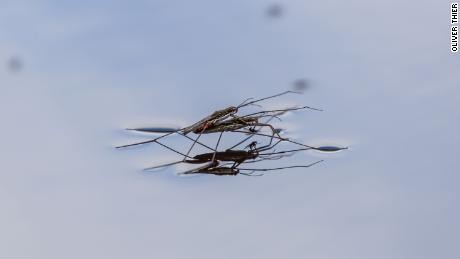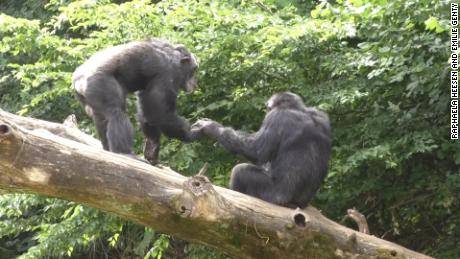This butterfly was the first to go extinct in the US because of humans
Sign up for CNN's Wonder Theory science newsletter. Explore the universe with news on fascinating discoveries, scientific advancements and more .
(CNN) As the first North American insect to go extinct due to humans, a blue butterfly has become an icon for insect conservation -- and what happens when humans destroy habitats without thought for the creatures living in them.
The last of the Xerces blue butterflies fluttered through the air in San Francisco in the early 1940s. Now, they can only be seen in glass displays at museums.
These periwinkle pearly-winged insects lived in the coastal sand dunes along San Francisco and were first characterized by scientists in 1852. When urban development swept through this part of California, the sandy soils were disturbed. This caused a ripple effect, wiping out species of the plant the Xerces caterpillars used. The habitat change was too great for the Xerces blue butterfly, and the species went extinct.
"The Xerces blue butterfly was the first insect in the United States that was documented to be driven to extinction by human activities," said Corrie Moreau, director of the Cornell University Insect Collection, Martha N. and John C. Moser professor of arthropod biosystematics and biodiversity at Cornell, and author of a new study about the Xerces butterfly.
"Habitat conversion and urban development caused the loss of this species. The Xerces blue butterfly has become an icon for insect conservation. In fact, the largest insect conservation organization is even named after this species."
Read More
But scientists have long questioned if Xerces was a distinct species, or if it was a subspecies or really just an isolated population of another type of butterfly, the silvery blue that lives across the western United States and Canada. Is the insect apocalypse really upon us? It's complicated, say researchers Moreau, who began working on this as a researcher at Chicago's Field Museum, and her colleagues turned to museomics to answer the question. The new study published Tuesday in the journal Biology Letters. "Museomics is the use of museum collections for genome sequencing and other analytical techniques that could not even be imagined when the majority of museum specimens were collected," Moreau said. "What makes this so groundbreaking is that we can address questions that cannot be answered any other way. This study is a great example of this since we cannot go out and collect the Xerces blue butterfly and the only way to address genetic questions about this species is by turning to museum collections." The Field Museum is home to multiple specimens of the Xerces blue butterfly, so Moreau and her colleagues decided to extract DNA from a 93-year-old butterfly specimen in the museum's collection and see if it met the conditions for belonging to a unique species. This 93-year-old Xerces blue butterfly specimen was used in a study to prove it was once a unique species. {"@context": "http://schema.org","@type": "ImageObject","name": "This 93-year-old Xerces blue butterfly specimen was used in a study to prove it was once a unique species.","description": "This 93-year-old Xerces blue butterfly specimen was used in a study to prove it was once a unique species.","url": "//cdn.cnn.com/cnnnext/dam/assets/210720141720-01-xerces-blue-butterfly-large-169.jpg"} How do you extract DNA from a nearly century-old pinned butterfly? Very carefully, using forceps. Moreau was able to retrieve DNA after pinching off a tiny part of the insect's abdomen. "It was nerve-wracking, because you want to protect as much of it as you can," Moreau said. "Taking the first steps and pulling off part of the abdomen was very stressful, but it was also kind of exhilarating to know that we might be able to address a question that has been unanswered for almost 100 years that can't be answered any other way." If you want to save bumble bees, plant these flowers in your yard The Field Museum also includes the Grainger Bioinformatics Center, which has the capability to sequence and analyze DNA. "DNA is a very stable molecule, it can last a long time after the cells it's stored in have died," said Felix Grewe, lead study author and codirector of the Grainger Bioinformatics Center, in a statement. The study team was able to retrieve enough threads of DNA to compare it with the silvery blue butterfly's DNA and determine that the Xerces blue butterfly was a separate species -- and humans indeed caused it to go extinct. "It's interesting to reaffirm that what people have been thinking for nearly 100 years is true, that this was a species driven to extinction by human activities," Grewe said. "When this butterfly was collected 93 years ago, nobody was thinking about sequencing its DNA. That's why we have to keep collecting, for researchers 100 years in the future." The Field Museum has a collection of extinct Xerces blue butterflies. {"@context": "http://schema.org","@type": "ImageObject","name": "The Field Museum has a collection of extinct Xerces blue butterflies.","description": "The Field Museum has a collection of extinct Xerces blue butterflies.","url": "//cdn.cnn.com/cnnnext/dam/assets/210720141728-02-xerces-blue-butterfly-large-169.jpg"} Next, the researchers want to understand if this species, which was considered to be genetically diverse, experienced a decline in diversity as it neared extinction. That could be a contributing factor to its untimely end. The team was able to retrieve enough genetic information to prove that Xerces was a unique species, but it's not enough to resurrect the butterflies, the researchers said. And many factors need to be considered before trying to bring a species back through de-extinction. "Although I know there are some people interested in potentially resurrecting this species, I think we have a long way to go before we would be able to actually do this," Moreau said. "It would require significant time and financial resources to not only recapitulate its genome, but also establish the required host plants for the larvae and native symbiotic ants. During this time of a global insect decline, I would prefer to see our resources put towards saving those species already endangered or protecting critical habitat." Meanwhile, other butterflies are experiencing decline, like the El Segundo Blue, due to a loss of its sand dune habitat, and the Karner Blue due to the loss of the blue lupine flower its caterpillars use, according to Moreau. "Before we start putting a lot of effort into resurrection, let's put that effort into protecting what's there and learn from our past mistakes," Grewe said. The researchers noted that we're in the middle of what many scientists dub the insect apocalypse as species decline around the world -- something humans have contributed to greatly. Scientists have finally worked out how butterflies fly "The current 'insect apocalypse' is really a death by a thousand cuts," Moreau said. "Pesticide use, land use modification and climate change are likely the major factors causing these global insect declines and all of these are due to human activities. I think it is in our best interest to try to mitigate as many of these as we can since every species on the planet is important." Insects are more crucial to our lives than most people realize, the researchers said. While all of them may not be as pretty or attention-getting as the Xerces blue butterfly, they aerate soil and aid in plant growth, which feeds everything else. "As insects are critical for any ecosystem the loss of any one species has ripple effects through the community," Moreau said. "As we can see from these examples above the interconnectedness of species from mutualists to food plants to habitat requirements can have huge impacts on the survival of a species. To be honest without insects our planet would become inhospitable to humans within a matter of months. We need insects even if we don't always realize it."












Write a Comment